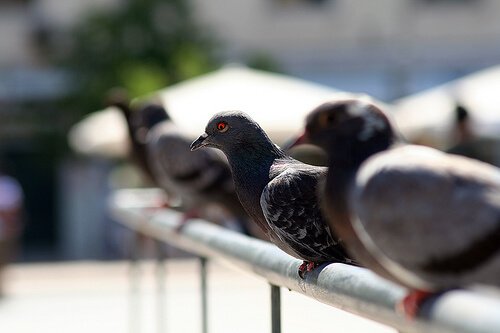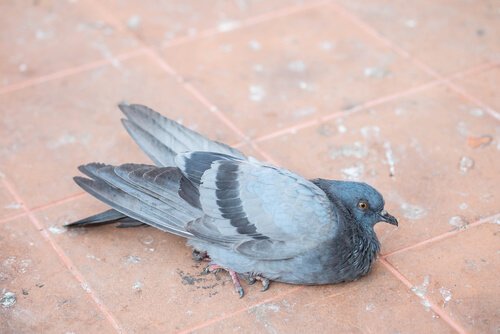Diseases That Pigeons Have

Some people call them the “rats of the sky”, and many people greatly despise them. A lot of cities consider them as a pest and blame them for transmitting diseases to humans. That’s why in today’s article you can read about the diseases that pigeons actually have.
The main diseases pigeons have
Like many birds, they’re from the Columbidae family and they can get infected by viruses, bacteria, fungi, or parasites. They can also contract many non-infectious diseases.
Pigeons that have been raised in lofts can take medications to treat those diseases. However, taking preventive measures through vaccines, vitamins, medication, or simple good hygiene is always better.
Below are some of the diseases:
Trichomoniasis
It is estimated that about 80% of adult pigeons coexist with protozoans, which cause this parasitic disease. It can be fatal for younger pigeons and other animals with weak immune systems.
Here are some of the symptoms of trichomoniasis:
- Apathy.
- Feathers standing up.
- Watery diarrhea.
- Lack of appetite.
- Intense thirst.
- Weight loss.
- Hard yellow-white crust on the mouth, throat, and sometimes the stomach.
- Respiratory problems.
They get this disease by drinking contaminated water or eating food that has been thrown up by an infected pigeon. They sometimes infect their own nest when feeding their young with regurgitated food. These kinds of parasites can also infect their internal organs and cause damage.

Some of the diseases that infect pigeons can be transimitted to humans. This is why it’s so important to practise good hygiene and take preventive measures.
Paramyxovirus
This disease has a high fatality rate. Pigeons with this disease experience a loss of appetite and drink less water. Their feces become runny and they lose weight. As the disease progresses, these animals will begin to develop nervous system disorders, such as:
- Involuntary movements and a lack of coordination (balancing, tumbling, spinning around, falling backward, etc…)
- Difficulty picking up grains due to optic nerve damage. Sometimes you may have to feed your pigeon with a piping bag or a syringe.
- Torticollis.
- Seizures.
- Paralysis in the wings and feet.
This disease is transmitted through direct contact with infected birds. The infections come from the secretions of the eyes, lungs, or stomach. Plus, indirect contamination can also take place by having contact with loose feathers, food, water, or places they spend most of their time at.
Salmonella (paratyphoid)
This deadly bacterial infection of the intestines usually happens in younger pigeons and birds. However, pigeons that recover may become carriers and transmit the disease through the shells of the eggs they lay as adults. The symptoms of the disease are:
- Thin, greenish feces.
- Fattening of the cloaca.
- Weight loss.
- Shortness of breath.
- General weakness.
- Drooping wings.

This disease can spread to organs like the liver, kidneys, and spleen. Plus, it can also attack the brain and spinal cord, which leads to loss of balance, paralysis, and torticollis. This disease is transmitted through food and water, or infected dust molecules. Pigeons can also spread it to humans, but only through contact over an extended period of time.
Coryza
Coryza is one of the other diseases that pigeons have. This disease is very common during the fall and the beginning of spring. It’s a severe respiratory illness that’s related to cold, dampness, overpopulation, and the stress caused by competing for food and mates. Lacking vitamin A is another major cause of this disease. Here are some of the symptoms:
- Sneezing
- Sticky and smelly nasal secretion.
- Troubles breathing, which forces the pigeon to keep its beak open.
Also, pigeons can experience tearing from the eyes due to swelling in the tear ducts. Any pigeon that recovers from this disease will become lifetime carriers and transmit the disease to their offspring.
Some people call them the “rats of the sky”, and many people greatly despise them. A lot of cities consider them as a pest and blame them for transmitting diseases to humans. That’s why in today’s article you can read about the diseases that pigeons actually have.
The main diseases pigeons have
Like many birds, they’re from the Columbidae family and they can get infected by viruses, bacteria, fungi, or parasites. They can also contract many non-infectious diseases.
Pigeons that have been raised in lofts can take medications to treat those diseases. However, taking preventive measures through vaccines, vitamins, medication, or simple good hygiene is always better.
Below are some of the diseases:
Trichomoniasis
It is estimated that about 80% of adult pigeons coexist with protozoans, which cause this parasitic disease. It can be fatal for younger pigeons and other animals with weak immune systems.
Here are some of the symptoms of trichomoniasis:
- Apathy.
- Feathers standing up.
- Watery diarrhea.
- Lack of appetite.
- Intense thirst.
- Weight loss.
- Hard yellow-white crust on the mouth, throat, and sometimes the stomach.
- Respiratory problems.
They get this disease by drinking contaminated water or eating food that has been thrown up by an infected pigeon. They sometimes infect their own nest when feeding their young with regurgitated food. These kinds of parasites can also infect their internal organs and cause damage.

Some of the diseases that infect pigeons can be transimitted to humans. This is why it’s so important to practise good hygiene and take preventive measures.
Paramyxovirus
This disease has a high fatality rate. Pigeons with this disease experience a loss of appetite and drink less water. Their feces become runny and they lose weight. As the disease progresses, these animals will begin to develop nervous system disorders, such as:
- Involuntary movements and a lack of coordination (balancing, tumbling, spinning around, falling backward, etc…)
- Difficulty picking up grains due to optic nerve damage. Sometimes you may have to feed your pigeon with a piping bag or a syringe.
- Torticollis.
- Seizures.
- Paralysis in the wings and feet.
This disease is transmitted through direct contact with infected birds. The infections come from the secretions of the eyes, lungs, or stomach. Plus, indirect contamination can also take place by having contact with loose feathers, food, water, or places they spend most of their time at.
Salmonella (paratyphoid)
This deadly bacterial infection of the intestines usually happens in younger pigeons and birds. However, pigeons that recover may become carriers and transmit the disease through the shells of the eggs they lay as adults. The symptoms of the disease are:
- Thin, greenish feces.
- Fattening of the cloaca.
- Weight loss.
- Shortness of breath.
- General weakness.
- Drooping wings.

This disease can spread to organs like the liver, kidneys, and spleen. Plus, it can also attack the brain and spinal cord, which leads to loss of balance, paralysis, and torticollis. This disease is transmitted through food and water, or infected dust molecules. Pigeons can also spread it to humans, but only through contact over an extended period of time.
Coryza
Coryza is one of the other diseases that pigeons have. This disease is very common during the fall and the beginning of spring. It’s a severe respiratory illness that’s related to cold, dampness, overpopulation, and the stress caused by competing for food and mates. Lacking vitamin A is another major cause of this disease. Here are some of the symptoms:
- Sneezing
- Sticky and smelly nasal secretion.
- Troubles breathing, which forces the pigeon to keep its beak open.
Also, pigeons can experience tearing from the eyes due to swelling in the tear ducts. Any pigeon that recovers from this disease will become lifetime carriers and transmit the disease to their offspring.
This text is provided for informational purposes only and does not replace consultation with a professional. If in doubt, consult your specialist.







